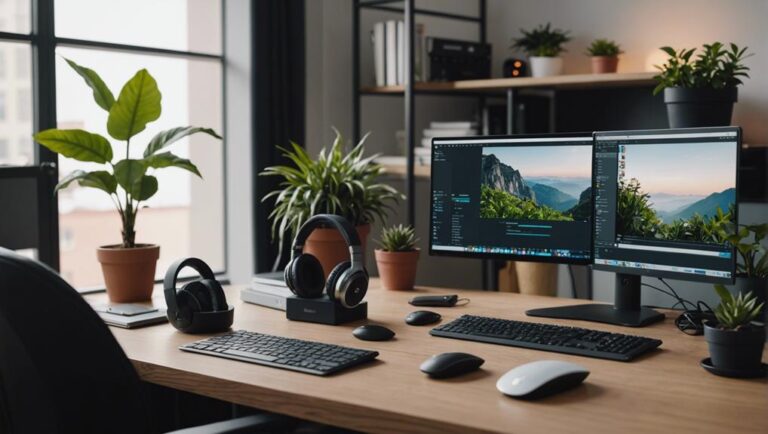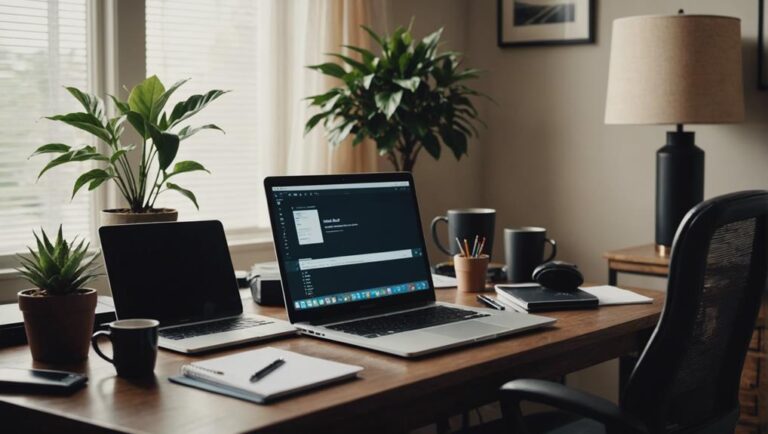Time Management Techniques for Remote Workers
Boost your productivity as a remote worker with key time management techniques. Define work hours clearly and stick to them for a balanced routine. Set boundaries to enhance focus during tasks and virtual meetings. Prioritize tasks wisely, delegate when needed, and use time-blocking methods. Utilize time-tracking tools for insights into productivity patterns and goal setting. Minimize distractions in a dedicated workspace for peak concentration. Remember, mastering these techniques can transform your remote work experience.
Setting Clear Boundaries
To effectively manage your time as a remote worker, establish clear boundaries between your work and personal life. Personal boundaries are essential for maintaining a healthy work-life balance.
When working remotely, it can be challenging to separate your professional responsibilities from your personal time, leading to burnout and decreased productivity. Setting clear boundaries means defining specific work hours and sticking to them. Avoid the temptation to work outside of these hours, as it can disrupt your personal life and impact your overall well-being.
Additionally, establish professional boundaries during virtual meetings. Treat these meetings as you'd in-person ones, by dressing appropriately and setting up a designated workspace. Avoid multitasking during meetings to show respect for your colleagues' time and maintain focus.
Setting professional boundaries during virtual meetings helps to create a sense of professionalism and structure in your remote work environment, enhancing overall productivity and collaboration. Remember, clear boundaries are key to successfully managing your time and responsibilities as a remote worker.
Establishing a Daily Routine
To maximize your productivity as a remote worker, establishing a daily routine is key.
Incorporating morning rituals can help you start your day with focus and intention.
Setting clear boundaries within your routine can further enhance your productivity throughout the day.
Morning Rituals for Focus
Start your day with intentional morning rituals that set the tone for focus and productivity as a remote worker. Begin by reflecting on the previous day during your evening reflection, identifying accomplishments and areas for improvement. This practice can help you clear your mind and prepare for the day ahead.
Upon waking, engage in mindful breathing exercises to center yourself and promote mental clarity. Take a few moments to focus on your breath, inhaling deeply through your nose and exhaling slowly through your mouth. This simple practice can help reduce stress and increase your ability to concentrate on tasks.
Following mindful breathing, consider incorporating light physical activity into your morning routine. Whether it's a short walk, stretching, or yoga, moving your body can boost energy levels and enhance focus for the day ahead.
Setting Boundaries for Productivity
Establishing a daily routine is essential for setting boundaries that enhance productivity as a remote worker. When working from home, it's easy for work life balance to blur, leading to burnout. To avoid this, create a structured routine that separates work hours from personal time. Start by setting specific work hours and sticking to them. This helps in maintaining boundaries with family members who might assume your availability throughout the day. Communicate your schedule clearly to them, so they understand when you're working and when you're free to engage in personal activities.
Incorporating regular breaks into your routine is critical for maintaining focus and preventing fatigue. Use these breaks to relax, stretch, or connect with loved ones. Setting boundaries with family members during work hours is essential for uninterrupted focus. Clearly define your workspace as off-limits during certain times to minimize distractions.
Prioritizing Tasks Effectively
When working remotely, prioritizing tasks effectively is key to staying productive. Task importance ranking helps you focus on what matters most, ensuring that essential duties are completed first.
Daily to-do lists can further aid in organizing your workload and keeping you on track throughout the day.
Task Importance Ranking
How can you effectively prioritize tasks based on their importance as a remote worker? Task delegation and time blocking are crucial strategies to manage your workload efficiently. Start by distinguishing between urgent and important tasks. Urgent tasks demand immediate attention, while important tasks contribute to your long-term goals. Categorize your tasks based on these criteria to determine their significance.
Once you have identified the importance of each task, consider task delegation. Delegate tasks that are less critical or can be handled by others, allowing you to focus on high-priority assignments. This not only frees up your time but also ensures that each task is tackled by the most suitable person.
Implement time blocking to allocate dedicated time slots for different tasks based on their importance. By setting aside specific periods for essential tasks, you can maintain focus and prevent distractions. This method enhances productivity and helps you accomplish tasks in a structured manner, making sure that important responsibilities aren't overlooked.
Daily To-Do Lists
Create your daily to-do list by prioritizing tasks effectively to maximize your productivity as a remote worker. Start by implementing time blocking, where you allocate specific time slots for different tasks based on their priority. This method helps you focus on one task at a time, increasing efficiency and reducing distractions.
Additionally, consider task batching, grouping similar activities together to streamline your workflow. For example, schedule all your meetings in one block to avoid context switching throughout the day.
To further enhance your daily to-do list, engage in weekly planning sessions. Take time at the beginning of each week to outline your priorities, deadlines, and goals. This practice sets a clear direction for each day and ensures that you stay on track with your long-term objectives.
Furthermore, incorporate focus tracking into your routine by monitoring how you spend your time. By analyzing where your attention goes, you can identify areas for improvement and make necessary adjustments to boost productivity.
Applying these techniques to your daily to-do list will help you work smarter, not harder, as a remote worker.
Utilizing Time-Tracking Tools
Time-tracking tools are essential for remote workers to efficiently monitor and manage their daily activities. These tools offer various benefits, including providing insights into how time is spent, increasing productivity, and aiding in identifying areas for improvement. For remote workers facing challenges such as blurred work-life boundaries and potential distractions at home, time-tracking tools can be particularly valuable.
By utilizing time-tracking tools, you can gain a clear understanding of where your time is being allocated throughout the day. This awareness enables you to prioritize tasks effectively, set realistic goals, and enhance time management skills. Additionally, tracking your time allows you to analyze patterns, identify time-wasting activities, and make adjustments to optimize your workflow.
Whether you prefer manual time entries or automated tracking systems, selecting a time-tracking tool that aligns with your work style is important. Experiment with different tools to find the one that best suits your needs and enhances your productivity as a remote worker.
Minimizing Distractions
To minimize distractions while working remotely, set up a quiet workspace that's conducive to focus.
Turn off digital notifications to avoid interruptions and maintain your concentration.
Schedule specific break times to give yourself moments of rest without letting distractions seep in.
Quiet Workspace Setup
Creating a designated workspace where distractions are minimized is essential for remote workers to maintain focus and productivity. To achieve this, consider soundproofing options like thick curtains, sound-absorbing panels, or noise-canceling headphones to block out external noises.
Vital furniture plays a significant role in ensuring comfort and reducing physical distractions. Invest in a supportive chair, an adjustable desk to switch between sitting and standing, and proper lighting to prevent eye strain.
When setting up your quiet workspace, position your desk facing away from high-traffic areas to minimize interruptions. Keep your workspace clutter-free and organized to create a conducive environment for concentration. Personalize your space with calming elements like plants or soothing colors to promote a sense of tranquility.
Digital Notifications off
Turn off digital notifications on your devices to minimize distractions and stay focused while working remotely. Being mindful of how technology impacts your productivity is essential. Silence notifications to create a more conducive work environment.
Constant pings and alerts can interrupt your workflow and fragment your attention. By turning off digital notifications, you take control of your time and reduce the urge to constantly check your devices. This simple step allows you to concentrate on tasks without unnecessary interruptions.
Mindful technology usage involves being intentional about how you engage with your devices. Instead of reacting to every notification, designate specific times to check messages and emails. This approach helps you manage distractions effectively and allocate your focus where it's needed most.
Silencing notifications not only enhances your productivity but also promotes a sense of calm in your remote workspace. By proactively managing digital interruptions, you create a more peaceful environment that supports deep work and concentration.
Scheduled Break Times
Consider scheduling specific break times strategically to minimize distractions and optimize your productivity while working remotely. Flexible break schedules can help you maintain focus during work hours by allowing you to anticipate and plan for designated relaxation periods. By incorporating mindful relaxation techniques into your breaks, such as deep breathing exercises or quick stretches, you can rejuvenate your mind and body, enhancing your overall efficiency when you return to work.
Set aside time for breaks that align with your natural energy levels and workflow. Whether it's a short break every hour or longer breaks at strategic intervals, find a schedule that works best for you.
During these breaks, step away from your workspace, move around, and engage in activities that promote relaxation and mental clarity. By intentionally disconnecting from work tasks, you can prevent burnout and maintain a healthy work-life balance.
Implementing Pomodoro Technique
To enhance your productivity as a remote worker, incorporating the Pomodoro Technique can help you better manage your time and focus on tasks effectively. The Pomodoro Technique involves breaking your workday into intervals, traditionally 25 minutes long, separated by short breaks. During each 25-minute interval, known as a Pomodoro, you concentrate solely on the task at hand, tracking your time to guarantee maximum productivity. Utilizing time tracking tools or simple timers can aid in this process, keeping you accountable and helping you stay on track.
Implementing Pomodoro breaks can prevent burnout and maintain your efficiency throughout the day. By taking short breaks between Pomodoros, typically around 5 minutes, you allow your mind to rest and recharge, which can boost your overall productivity. These brief pauses also help in maintaining focus and preventing fatigue, ensuring that you can work consistently at your best capacity.
Incorporating the Pomodoro Technique into your remote work routine can significantly enhance your time management skills and improve your ability to tackle tasks with increased concentration and efficiency.
Creating a Dedicated Workspace
Boost your remote work productivity by creating a designated workspace where you can focus and maximize your efficiency.
Personalizing your workspace can greatly impact your motivation and overall work experience. Start by choosing a space in your home that's quiet, well-lit, and free from distractions. Customize it with items that inspire you, such as plants, motivational quotes, or personal touches that make you feel comfortable and productive.
In addition to personalization, make sure your workspace is set up ergonomically. Invest in a comfortable chair that supports your back and promotes good posture. Position your computer screen at eye level to prevent neck strain, and use a keyboard and mouse that are easy on your wrists. Consider incorporating standing options like a desk converter to break up long periods of sitting.
Setting Realistic Goals
To maximize your productivity in your dedicated workspace, begin by setting realistic goals that align with your remote work objectives. Effective goal setting strategies involve breaking down tasks into manageable segments. Use time tracking techniques to allocate specific timeframes for each task, ensuring a focused approach. Establishing achievable milestones provides a clear roadmap for progress.
Accountability partners can be valuable assets in maintaining motivation and staying on track. Collaborate with a colleague or friend to set mutual goals and check in regularly to discuss progress. This external support system can help you remain accountable and motivated.
Progress tracking is essential to evaluate your performance against set goals. Utilize tools like digital planners or task management apps to monitor your accomplishments and adjust your strategies as needed. Reflect on your achievements and challenges to refine your goal-setting process continually.
Taking Regular Breaks
Make sure to incorporate regular breaks into your remote work routine to maintain focus and productivity throughout the day. Taking short breaks can help prevent burnout and improve your overall well-being.
Utilize mindful breathing techniques during your breaks to relax your mind and reduce stress. Close your eyes, take deep breaths, and focus on the sensation of breathing to center yourself and boost mental clarity.
Incorporating stretch breaks into your day is also essential. Prolonged sitting can lead to muscle stiffness and decreased circulation. Stand up, stretch your arms, roll your shoulders, and touch your toes to increase blood flow and prevent physical discomfort.
These simple movements can help you feel more energized and ready to tackle your tasks effectively.
Communicating Effectively
Effective communication is key to fostering collaboration and ensuring productivity in a remote work setting. When working remotely, virtual team building becomes vital to create a sense of unity among team members who may be physically distant.
To enhance remote collaboration, utilizing various communication tools such as video conferencing, instant messaging apps, and project management platforms can streamline interactions and keep everyone on the same page.
Establishing regular check-ins with your team through virtual meetings can help clarify tasks, address any issues promptly, and maintain a sense of connection. It's crucial to be proactive in sharing updates, progress reports, and asking for feedback to ensure that everyone is aligned with the team's goals and objectives.
Encouraging open and transparent communication channels where team members feel comfortable expressing their ideas and concerns fosters a positive remote work environment. By prioritizing effective communication strategies and actively engaging with your team, you can promote better virtual team building and enhance remote collaboration for increased productivity and overall success.
Conclusion
In the fast-paced world of remote work, mastering time management is like steering a ship through turbulent waters. By setting clear boundaries, establishing routines, and prioritizing tasks, you can navigate these challenges with ease.
Remember, just like a skilled captain, you have the power to chart your course and reach your destination successfully. Keep honing your time management skills and watch as your productivity and efficiency soar to new heights.







